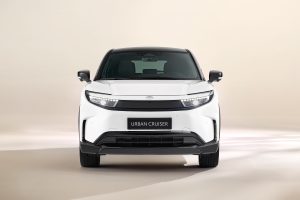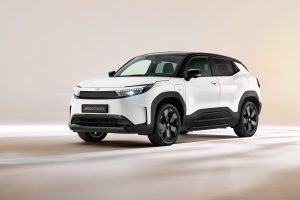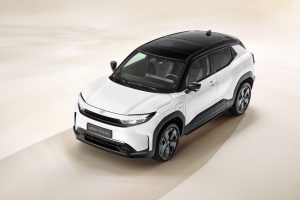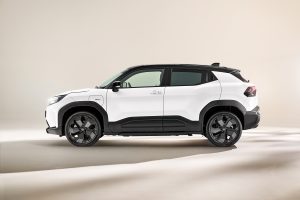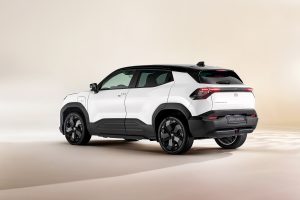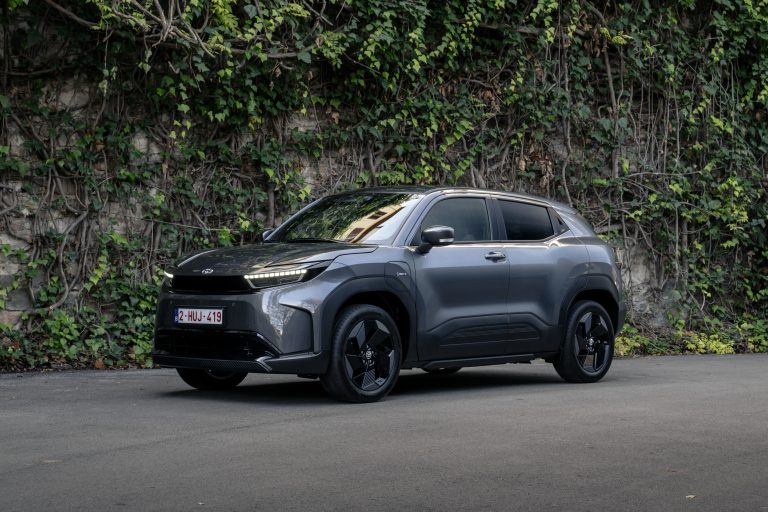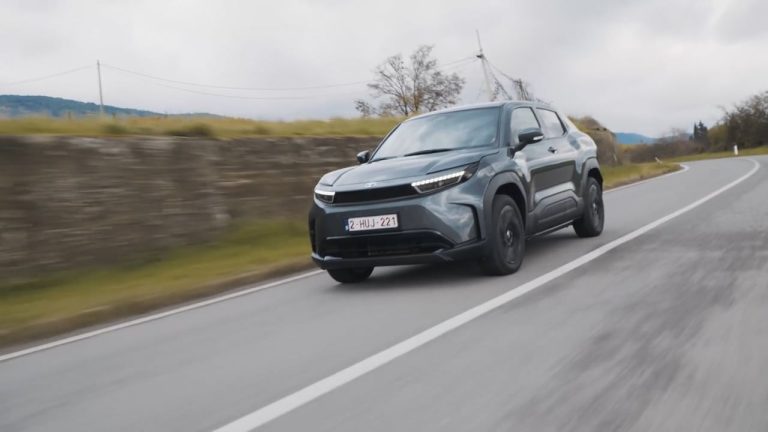The all-new Toyota Urban Cruiser: first media prototype drive
The all-new Toyota Urban Cruiser: first media prototype drive
- An authentic SUV in both styling and performance, built on a dedicated BEV platform
- Spacious and flexible interior with sliding rear seat system
- All-new electric powertrain with compact and efficient eAxles
- Two battery options – 49 kWh and 61 kWh – to cover a wide range of customer preferences
- Up to 265 miles driving range
- Urban Cruiser joins the full hybrid Yaris Cross to give Toyota in-depth coverage of Europe’s crucial B-SUV segment
- UK model range and pricing to be announced shortly
Introduction
The all-new Urban Cruiser accelerates Toyota’s development of its battery electric vehicle (BEV) range, giving the company a powerful presence in the rapidly expanding compact (B-segment) SUV market.
True to Toyota’s customer first approach, the Urban Cruiser range includes two battery options with different capacities, to suit different customer requirements in terms of driving range and performance.
In Europe, three versions are available at launch: a front-wheel drive model with a 49kWh battery; and front and all-wheel drive versions with a 61kWh battery. Details of the UK model range will be announced shortly.
Urban Cruiser will deliver a generous driving range of up to 265 miles (FWD, 61kWh battery) in the combined WLTP cycle. Both batteries use lithium iron phosphate technology which has the benefits of durability and low cost. A thermal management system helps ensure an optimum battery temperature is maintained, including in very cold and very hot conditions.
The SUV credentials are reflected in a robust design, while the advanced EV powertrain is recognised in the signature Toyota hammerhead frontal treatment. Inside, cabin and load space have been maximised thanks to clever design and packaging of the powertrain components. With a 2,700mm wheelbase, the interior is open, spacious and versatile, with a sliding and split-folding rear seat system that can extend passenger room to rival larger models.
Information and multimedia functions are fully digital, easy to access with an instrument combimeter and central touchscreen display that are seamlessly integrated in the dashboard design. On-board connectivity is similarly well-catered for, with front and rear USB ports and wireless smartphone integration. The MyToyota app gives owners the freedom to use functions remotely, including scheduling battery charging and checking the battery’s state of charge.
Impactful SUV design
Urban Cruiser stands out with a powerful design. Developed on the theme “Urban Tech,” its sophisticated, mature styling gives a bold appearance from every angle.
Its SUV character is evoked in a strong lower body treatment with robust sill and wheel arch mouldings and lower bumper sections.
The “hammerhead” front end – a contemporary Toyota design cue – is a key element, accentuated by a thin line around its leading edge. The visual impact is enhanced by slim headlight units with light guides for the horizontal LED daytime running lights and turn indicators and a U-shaped garnish around a bi-LED for the headlight high and low beam. A strong lower bumper with a gloss black finish accentuates the car’s wide stance.
At the rear, a powerfully designed rear light arrangement spans the width of the back door, wrapping round into the car’s muscular haunches. LED lights are arranged in parallel lines to create a distinctive illumination signature.
Overall dimensions are slightly greater than Toyota’s full hybrid compact SUV, the Yaris Cross.
| DIMENSIONS | URBAN CRUISER | +/- vs YARIS CROSS |
| Overall length (mm) | 4,285 | +105 |
| Overall width (mm) | 1,800 | +35 |
| Overall height (mm) | 1,635 | +45 |
| Wheelbase (mm) | 2,700 | +140 |
Although Urban Cruiser has a longer wheelbase, its turning radius (tyre) is just 5.2m making for easy manoeuvrability in urban streets and tight parking spaces.
Dedicated BEV platform
Urban Cruiser is constructed on a dedicated new BEV platform, developed with cabin space and driving range as top priorities.
The main underfloor section dispenses with cross-members to accommodate the battery pack, which itself forms part of the vehicle’s structure. The battery is protected from collision damage by an outer frame and energy-absorbing side mounts.
With high-tensile steels used in key areas throughout the construction, strength and body rigidity are high, while weight is saved. The underfloor location of the battery helps secure a low centre of gravity, which promotes secure, stable handling performance and an agile driving character.
Aerodynamic performance helps reduce power consumption and maximise the car’s driving range, so Urban Cruiser has aero covers that extend across the entire underfloor area, including the front and rear sections. Smoothing of the airflow beneath the car is also helped by the battery pack having a flat, low-profile design.
Detailed measures have been taken to control noise and vibration that are potentially more noticeable in the absence of a conventional engine sound. Road noise is suppressed by the battery pack forming a structural member; while driving and wind noise is reduced by the use of sound-insulating baffles around the vehicle and a windscreen with sound-insulating glass. The front eAxle mounts also suppress unwelcome noise and vibration.
All-new battery-electric powertrain with two battery options
Urban Cruiser has an all-new battery-electric powertrain with a choice of two battery packs. Both batteries use lithium-iron phosphate technology, which has the combined benefits of durability and safety with lower cost. Acceleration is prompt and linear, both from start-off and at overtaking speeds.
The car is driven by a compact and efficient eAxle, which incorporates an electric motor, inverter and reduction gears. Design features, such as a small diameter motor and a long shaft have kept the unit small yet powerful. It also avoids intrusion in the cabin space.
The 49kWh battery contains 96 cells and has an output of 106kW (142bhp/144 DIN hp), 193Nm of torque and an estimated driving range (WLTP combined) of up to 214 miles.
Extending customer choice, there is also a 61kWh 120-cell unit. This produces 128kW (172bhp/174DIN hp) and 193Nm. The predicted range is up to 265 miles.
| Drivetrain | FWD | FWD |
| Battery capacity (kWh) | 49 | 61 |
| Driving range (WLTP combined, miles) | 214 | 265 |
| Power (kW/bhp/DIN hp) | 106/142/144 | 128/172/174 |
| Torque (Nm) | 193 | 193 |
| 0-62mph (sec) | 9.6 | 8.7 |
Measures to maximise the car’s potential driving range include a thermal management system that co-ordinates battery temperature control with the air conditioning control system to help stabilise performance in hot or cold weather, or in high-load driving conditions (extended high-speed cruising and repeated rapid charging). In winter conditions, the system helps optimise battery temperature; in hot weather, the liquid refrigerant in the air conditioning is used to cool the battery.
Further measures include an automatic front grille shutter to optimise airflow and a heat pump integrated as a standard equipment. Using seat heaters and a heated steering wheel (according to model grade/option) also support efficient use of power.
All versions of the Urban Cruiser can tow braked loads of up to 750kg.
Battery charging
When using DC charging, a battery charge from 10 to 80 per cent is expected to take 45 minutes. For 15 to 100 per cent charging with a three-phase 11kW AC power supply, the time should be around six hours; single-phase 7kW AC charging should accomplish the same charging performance in about 9.5 hours.
The system includes a “My Room” charging mode that allows drivers to use the air conditioning and audio system while sitting in their vehicle while charging is in progress.
Peace of mind battery guarantee
Like all new Toyota BEVs, the Urban Cruiser promises long-lasting battery quality, durability, and reliability. Toyota’s Battery Care Program ensures the battery is covered each year for up to 10 years of vehicle age or up to 650,000 miles driven, contingent on an annual battery health check*.
Front-wheel drive model drive modes
The Urban Cruiser has four drive modes, selected using the shift-by-wire dial controller on the centre console.
Eco mode extends the car’s driving range with regulation of the air conditioning system’s power usage and response to the driver’s use of the accelerator pedal.
Normal mode provides prompt power delivery for everyday driving, while Sport mode sharpens the throttle response for a more agile driving experience.
The driver also has the option to use Pedal mode for driving with minimal use of the brake pedal. This mode offers three selectable levels of deceleration when the driver releases the throttle, allowing vehicle speed to be controlled using only the accelerator pedal.
The front-wheel drive model also benefits from a “snow mode” which controls drive torque to help reduce wheel-slip when driving on snow-covered roads.
Suspension and braking
The Urban Cruiser’s suspension is designed for comfort, stability, responsive steering, and low noise and vibration. A MacPherson strut arrangement is used at the front and a multi-link system at the rear. The rear suspension uses high-rigidity components to help maintain tyre contact with the road and improve ride comfort when travelling over uneven ground.
All four wheels are equipped with 18-inch ventilated disc brakes; those at the front with two-piston callipers. An electric parking brake is provided as standard, with a convenient brake hold function.
Spacious interior
Urban Cruiser’s comparatively long wheelbase (+140mm vs Yaris Cross) is key to a spacious and versatile interior. The sense of space and openness is amplified by a low-set instrument panel with strong horizontal lines and a soft-touch finish. Authentic SUV DNA is reflected in a high driving position with excellent all-round visibility, for driver and passengers alike.
To improve the driver’s view of the digital combimeter, the steering wheel has a slightly flattened top section, a design that also harmonises with the line of the instrument panel.
The centre console puts key controls in close reach, including a dial-type shift and electric brake. Cup holders and wireless charger (Excel grade) are integrated into the design, which forms a bridge over a handy open storage tray. This lower section also houses a power outlet and USB-A and USB-C ports for device connection and charging.
A rationalised design has seen some controls changed from physical switches to incorporation in the central multimedia touchscreen, including the seat heaters. The air conditioning system can be operated using either switches or the touchscreen.
The cabin has a black and dark grey finish with either fabric upholstery or (Excel grade) a combination of fabric and high-quality synthetic leather. The interior mood can be enhanced with an ambient lighting system that offers a choice of 12 colours and seven brightness levels, highlighting the door panels and console tray.
Thanks to a sliding rear seat system, the couple distance between front and rear passengers can be adjusted in a range from 690 to 850mm – the latter figure on a par with much larger SUVs. The seats split-fold in a 40:20:40 configuration and can also be reclined. The overall interior length is 3,050mm.
This designed-in flexibility allows the interior to be easily adapted for extra passenger comfort or extended load space, according to need. The load compartment measures 675mm deep, 1,020mm wide and 659mm high. With the rear seats folded, the depth extends to 1,455mm. When the rear seats are in their furthest forward position, there are 306 litres of luggage space up to the roof; with the seats in their rearmost position, the volume is 238 litres. Maximum space, with the seats fully folded, is 562 litres.
Convenient features for rear seat passengers include two USB ports in the rear console for device charging, a smartphone tray and folding rear centre armrest. Twin heater ducts are provided on Design and High grade models.
Digital user experience
The instrument panel seamlessly integrates the driver’s 10.25-inch digital combimeter and 10.1-inch multimedia display into a single unit. Both displays can be customised to suit the driver’s priorities for information and preferences for layout and readability.
The multimedia system is designed for fast, intuitive operation, offering both embedded navigation and a cloud-based system that is able factor in the latest traffic flow intelligence for time-efficient route planning.
Wireless smartphone integration via Apple CarPlay or Android Auto is also provided so the driver can access their preferred apps and services with ease. A wireless smartphone charger is included in the High-grade specification.
Customers can also monitor and manage their vehicle’s functions remotely using the convenient MyToyota App. This allows management of the battery’s charging schedule and checks on its state of charge, together with convenience functions such as door locking and unlocking and operation of the air conditioning system to cool or heat the cabin prior to starting a journey.
Safety and driver assistance
A 360-degree camera system, standard on Excel grade, uses cameras on the front, rear and sides of the vehicles to provide a complete view of the car’s surroundings for easy manoeuvring across rough ground or parking in tight spaces.
Safer, easier driving is provided by a comprehensive package of technically advanced active safety and driver assistance features, going beyond the provisions that might be expected in a compact SUV.
As standard, all models are equipped with a Pre-Collision System that can recognise imminent collision risks (with other vehicles, motorcycles, bicycles and pedestrians), alert the driver and, if necessary, initiate braking to help avoid or mitigate and impact. Should an impact occur, and an airbag is triggered, multiple collision braking activates the brakes and brake lights to help prevent a secondary collision.
Dynamic Radar Cruise Control and Lane Trace Assist take much of the burden out of driving by maintaining a selected speed and safe distance from vehicles ahead, with smooth braking and acceleration in line with the traffic flow. Lane Departure Alert and Road Sign Assistance help keep the car safely within its lane and give visual confirmation of speed limits and traffic commands in the driver’s digital combimeter.
The Driver Monitoring Camera constantly monitors the driver’s face to detect if they are drowsy, falling asleep or distracted. If it detects an issue, it will issue a warning sound and a message on the instrument display recommending the driver takes a break or keeps their eyes on the road.
On Excel grade models, the LED headlights have an Adaptive High-beam System that automatically adapts the forward illumination to maximise the driver’s view while avoiding dazzling oncoming drivers.
Easier, safer manoeuvring is supported by front and rear parking sensors and Rear Cross Traffic Alert system that warns of traffic approaching from either side when reversing out of a parking space or driveway. A Blind Spot Monitor is included in the specification, alerting the driver of vehicles passing on either side that might not be visible in the door and rear-view mirrors.
* Toyota’s confidence in the quality of the battery is reflected in a guarantee it will retain at least 70 per cent of its capacity up to 10 years of vehicle age, covered by the original EV Manufacturing Warranty until eight years of vehicle age or 100,000 miles, and with the Battery Care Programme up to 10 years of vehicle age or 650,000 miles driven that is activated by an annual EV Health Check (terms and conditions apply, according to local/national market conditions).
ENDS

